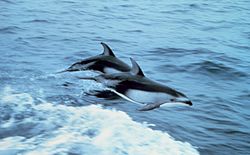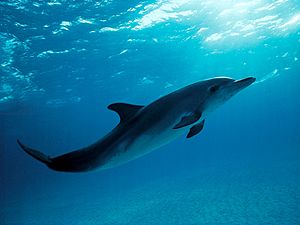Oceanic dolphin facts for kids
Quick facts for kids Oceanic dolphinTemporal range: late Miocene to Recent
|
|
|---|---|
 |
|
| Pacific white-sided dolphins | |
| Scientific classification | |
| Kingdom: | |
| Phylum: | |
| Class: | |
| Order: | |
| Suborder: | |
| Family: |
Delphinidae
Gray, 1821
|
Oceanic dolphins, also known as Delphinidae, are a large group of dolphins that live in the sea. There are about 30 different kinds of oceanic dolphins known today. This group includes some very big species that people often call "whales," like the famous killer whale and the pilot whales. Oceanic dolphins are part of a bigger family called Delphinoidea, which also includes porpoises and the beluga whale and narwhal. River dolphins are also related to these amazing sea animals.
These dolphins come in many sizes. The smallest is the Maui's dolphin, which is about 1.7 meters (5.6 feet) long and weighs around 50 kilograms (110 pounds). The largest is the killer whale, which can be up to 9.4 meters (31 feet) long and weigh 10 metric tons (11 short tons)! In some species, males are bigger than females. Dolphins have smooth, torpedo-shaped bodies and their front limbs are shaped like flippers. Some dolphins can swim super fast, up to 55 kilometers per hour (34.5 mph).
Most oceanic dolphins love to eat fish. They also enjoy squid and small crustaceans. However, some species, like the killer whale, have a special diet and eat other marine mammals and birds. All dolphins are meat-eaters. They usually have between 100 and 200 teeth, but some have fewer. Dolphins often travel in large groups called pods. These pods can have as many as a thousand dolphins! They use sounds to talk to each other, like low-pitched whistles. They also make high-pitched clicks to find things using echolocation. Baby dolphins are born after 10 to 18 months. They are born one at a time. Dolphins have a thick layer of fat called blubber under their skin. This blubber helps them stay warm in cold water.
Oceanic dolphins live all over the world. Most species prefer warm, tropical waters. But some, like the right whale dolphin, like colder places. The killer whale can be found in oceans everywhere. Male dolphins often mate with many females each year. But females usually only have babies every two or three years. Baby dolphins are usually born in the spring and summer. The mothers take care of their young. Dolphins make many different sounds, like clicks and whistles.
Sadly, oceanic dolphins face some dangers. In some places, like Japan, they are hunted. They can also get caught accidentally in fishing nets. Their homes are sometimes damaged, and they can be harmed by pollution in the ocean. Dolphins have been important in many cultures for a long time. They appear in books and movies, like the film Free Willy. Sometimes, dolphins are kept in special parks and trained to perform shows. The bottlenose dolphin is the most common type of dolphin kept in these places.
Contents
About Oceanic Dolphins
Oceanic dolphins belong to a family called Delphinidae. This family includes many different kinds of dolphins.
Types of Oceanic Dolphins
Here are some of the different types of oceanic dolphins:
- Melon-headed whale
- Orca (Killer whale)
- Pygmy killer whale
- False killer whale
- Pilot whales (Long-finned and Short-finned)
- Common dolphins (Long-beaked and Short-beaked)
- Right whale dolphins (Northern and Southern)
- Tucuxi
- Humpback dolphins (Pacific, Indian, and Atlantic)
- Spotted dolphins (Atlantic and Pantropical)
- Clymene dolphin
- Spinner dolphin
- Striped dolphin
- Rough-toothed dolphin
- Bottlenose dolphins (Common and Indo-Pacific)
- Chilean dolphin
- Commerson's dolphin
- Heaviside's dolphin
- Hector's dolphin
- Risso's dolphin
- Fraser's dolphin
- White-sided dolphins (Atlantic and Pacific)
- Dusky dolphin
- Hourglass dolphin
- Peale's dolphin
- White-beaked dolphin
- Irrawaddy dolphin
- Australian snubfin dolphin
Dolphin Biology
What They Look Like
Oceanic dolphins come in many shapes and sizes. They are the most varied group of all cetaceans (whales, dolphins, and porpoises). They can be as small as 1.2 meters (4 feet) long and weigh 40 kg (88 lb), like Heaviside's dolphin. Or they can be as big as 9 meters (30 feet) long and weigh 10 tons, like the killer whale. Most species weigh between 50 and 200 kg (110 and 440 lb).
Dolphins usually have curved fins on their backs. Many have a clear "beak" at the front of their heads. They also have a rounded forehead called a melon. But there are always exceptions to these rules! Dolphins also have many different colors and patterns on their bodies.
Their bodies are shaped like a torpedo, which helps them swim fast. Their necks are not very flexible. Their front limbs are flippers, and they have no outside ear flaps. They have a big tail fin and a rounded head. A dolphin's skull has small eye sockets and a long snout. Their eyes are on the sides of their heads. In some species, female dolphins are larger than males.
Dolphins breathe through a hole on top of their head called a blowhole. When they breathe out warm air from their lungs, it can look like a steamy cloud in cold weather.
All oceanic dolphins have a thick layer of blubber. This blubber helps them stay warm in the cold ocean water. It also offers some protection from predators. Baby dolphins are born with a thin layer of blubber.
How They Move
Oceanic dolphins have two flippers on their underside near their head. They also have a dorsal fin on their back and a tail fin. These flippers have four finger-like bones inside them.
Dolphins are very fast swimmers. They are much faster than seals. A killer whale can swim up to 55 kilometers per hour (34.5 mph).
Their neck bones are fused together. This makes them very stable when swimming fast. But it also means they cannot turn their heads.
Dolphins swim by moving their tail fin and the back part of their body up and down. Their flippers are mainly used for steering. Some dolphins jump out of the water while swimming. This is called porpoising. It can help them travel faster because there is less drag in the air. Their bones are built to help them swim quickly. All dolphins have a dorsal fin. This fin helps them stay balanced and not spin around in the water.
How They Sense the World

A dolphin's ear is specially made for living in the ocean.
Dolphins send out high-frequency clicks from an organ called a melon. This melon is made of fat. The skull of a dolphin has a large dip where the melon sits. This allows dolphins to use biosonar to find their way around and locate objects.
Most dolphins do not have hair. But they do have tiny hair follicles. These might help them sense things.
A dolphin's eye is small for its body size. But they can still see very well. Their eyes are on the sides of their head. This means they see two separate pictures, unlike humans who see one combined picture.
Dolphins do not have olfactory lobes. This means they probably cannot smell anything.
It is thought that oceanic dolphins do not have a good sense of taste. Their taste buds are either very small or missing. However, some dolphins prefer certain kinds of fish. This suggests they might have some sense of taste.
Dolphin Behavior
What They Eat
Most oceanic dolphins mainly eat fish. They also eat some squid and small crustaceans. But some species are picky eaters. Some only eat squid. The killer whale is special because it also eats marine mammals and birds. All dolphins are pure meat-eaters. They usually have between 100 and 200 teeth. But some species have fewer.
Dolphins use different ways to catch food. One common way is called herding. A group of dolphins will push a school of fish together into a tight ball. Then, individual dolphins take turns swimming through the ball. They eat the fish that are stunned. Another method is corralling. Dolphins chase fish into shallow water. This makes them easier to catch. Killer whales and bottlenose dolphins have even been seen pushing their prey onto a beach to eat it. This is called beach or strand feeding. Some dolphins also hit fish with their tails. This stuns the fish and sometimes knocks them out of the water.
How They Talk
Oceanic dolphins can make many different sounds. They use special air sacs near their blowhole. There are three main types of sounds: whistles, burst-pulsed sounds, and clicks. Dolphins talk to each other using whistle-like sounds. These sounds are made by vibrating tissue, similar to how humans use their vocal cords. They also use burst-pulsed sounds, but we don't know everything about how they use them.
The clicks they make are used for echolocation. These clicks are sent out in a short series called a click train. The clicks get faster when a dolphin gets closer to something interesting. Dolphin echolocation clicks are some of the loudest sounds made by animals in the ocean.
Playing and Jumping
Oceanic dolphins often jump out of the water. They do this for many reasons. When they are traveling, jumping can save them energy. This is because there is less friction in the air than in the water. This way of moving is called porpoising. Other reasons for jumping include finding their way, showing off, fighting, communicating without words, having fun, and trying to shake off parasites.
Dolphins love to play. They often play with objects, with bubble rings they make themselves, with other dolphins, or even with other animals. Sometimes, dolphins play with humans. They have also been seen playing with Humpback whales and even dogs in the wild.
How Smart Are They?
Oceanic dolphins are known to be very smart. They can teach each other, learn new things, work together, plan, and even show sadness.
Scientists used to think that the size of an animal's brain was the main sign of how smart it was. For some dolphins, the brain to body mass ratio is second only to humans.
Some people believe that self-awareness shows very advanced thinking. Research suggests that dolphins, among other animals, are self-aware.
The most common test for self-awareness in animals is the mirror test. In this test, a temporary mark is put on an animal's body. Then, the animal is shown a mirror. Scientists watch to see if the animal recognizes itself.
Images for kids
-
Plate of dolphin sashimi
-
SeaWorld show featuring bottlenose dolphins and false killer whales
See also
 In Spanish: Delfines oceánicos para niños
In Spanish: Delfines oceánicos para niños



























